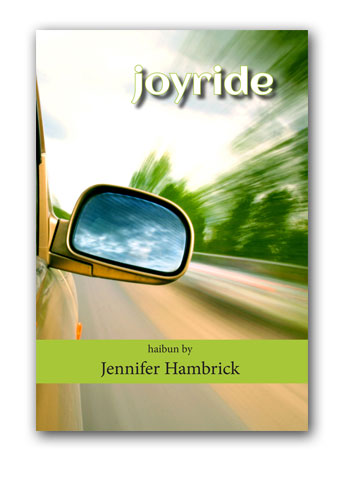
Book Review: Joyride
By Jennifer Hambrick
Published by Red Moon Press
Winchester, Virginia
2021, Paperback
ISBN: 978-1-947271-74-6
$15.00
Ordering Information
Reviewed by Rich Youmans
Jennifer Hambrick’s Joyride is aptly titled, and not just because automobiles (among other vehicles) appear in many of its pieces. Rather, it takes readers on a joyride in the metaphorical sense—through the experiences that make up a life’s journey. Her writing motors along as well, shifting gears smoothly throughout the collection’s 39 haibun (26, if you count a mid-book sequence as one work). Sometimes it accelerates with breathless energy as she recounts memorable moments or emotions, then slows to render a family scene or introduce one of the colorful characters met along the way. Occasionally she takes a detour simply to tell a humorous anecdote (which I guess should be expected in a book whose epigraph quotes Jerry Seinfeld). In all, it makes for an exhilarating trip.

The book is divided into three sections, the titles of which all pick up on the motoring/joyride theme. The first section, “Food Truck Love,” contains haibun that, for me at least, have a youthful feel; the majority focus on scenes from the narrator’s childhood, on family members, and on couples meeting and coming together (as in the section’s title poem, in which two food truck vendors fall in love and head off “to savor the flavor of the open road”). Some of these pieces are just flat-out fun. The opener, “Morning Zoo,” takes its title from the hyperactive radio show format familiar to so many drive-time motorists; from it, the haibun springboards into a humorous, surrealistic commute à la Russell Edson.
And as I motor through the neighborhood the deer pass each other on the sidewalk and I swear a buck makes a hat-tipping gesture to a doe, who curtsies. Then on Main Street I slam on the brakes and sit there watching a line of geese waddle across the street like clowns falling out of a clown car. While the geese are taking forever, those guys are squawking on the radio, and the car in the next lane over starts honking, but everyone knows geese don’t get that.
Elsewhere, Hambrick shifts to a more straightforward narrative. She’s an acute observer, and she knows how to lay out a scene with just enough detail. In “Small Fry,” for instance, she describes an episode during a road trip in the Appalachians. She and her parents have traveled to see their ancestors’ grave, renting a Lincoln Town Car that handles the region’s rough terrain “like a drunken dirigible.”
We return to the car, and Mom suggests we find a place for lunch. Dad drives a little way to a postage stamp–sized town suspended in Americana like a prom queen stuck in an evening dress. He squeezes the car into a parking space on the courthouse square, in front of a storefront diner advertising Blue Plate specials.
“What kind of fish is on your fish sandwich?” Dad asks the teenaged server.
In a thick Kentucky twang, she adds an extra syllable: “Breaded.”
The excerpts above give a glimpse into how Hambrick can vary her style without losing her voice. She also varies her haiku, both in tone and placement. While many of them fall at the end of the prose, others set the tone at the beginning of a haibun, or are embedded within the prose to emphasize specific points. Some of the haiku pick up on the exuberance in the narrative, as shown in this excerpt (from “Spiral”):
Watermelon crisps between my teeth … in candy-striped little-girl bikini, I spiral down drenched plastic, bounce like a bumper car from side to side, sliding down and down and down.
corkscrew lollipop the crazy colors of laughter
Juice fills my mouth pink-sweet . . . I surface through a lagoon of light and in the full stare of the sun, beads of water glitter at the ends of my ringlets and gap-toothed I giggle Dad into going down the slide.
In others, she uses the haiku to throttle back the pace. In “That Summer,” the 2018 winner of the Haiku Society of America’s haibun competition, she eschews the “speed bumps” of capitalization and uses repetition, rhythm, and rhyme to hurtle the reader along at breakneck speed, followed by a haiku that ends on a more subdued but no less resonant note:
everything was wheelie-o, bling-bloop, water in the frying pan, skittereedoo, everything purple and pink, crackly-crunch, salty-sweet, lemon-lime. everything high-heeled, lip glossed, hair moussed, thonged, pixie cut. everything school’s out, girlish pout, without a doubt, push and shout. everything untied, wide-eyed, jute-chinned, hemmed-in, take-n-bake, glass bead, knock-kneed. everything tilt-a-whirl, carousel, gyro tower, brown cow, show them how, nope, no going back now.
walking around
in a new place
first kiss
In general, the haiku complement the narrative nicely, although many rely on the prose for their strength. Traditionalists might argue that each haiku in a haibun should be able to stand on its own. Personally, I’ve read plenty of haibun over the years where the haiku, even if it couldn’t stand independently, still added to the prose and deepened my enjoyment of it. Take the capping haiku in one of the haibun referenced earlier, “Small Fry.” It comes right after that wonderfully twangy “Breaded”:
yonder over the mountain ridge a field of bluegrass
It’s well worded (especially that perfect “yonder”), but if I read that haiku alone, I’m not sure I’d give it a second thought (which could just show my limitations, but there you go). However, following that scene in the diner, it nicely captures the waitress’s phrasing with its evocative image and enriches the moment.
Throughout the book, Hambrick is not afraid to take chances or push the boundaries of the form. This trait is evident in the book’s second section, “Tanked: A Beach Odyssey,” which comprises 13 interrelated haibun that together tell of a couple’s ill-fated outing to the beach. It’s really a novella with three characters: an unnamed female grad-school student, who narrates the tale; her fiancé, Zed, a fellow student who invites her to take a break from Foucault and Derrida; and a car, nicknamed Mary Ellen, who becomes the “other woman.” The titles of the haibun offer a hint of the narrative’s arc—from “Cutting Out,” “Taste,” and “Footloose” to “Fuming,” “Screwed,” “Carzilla,” “Splat,” and “Cold Front.” In “Footloose,” the relationship between narrator and car becomes clear:
he bought the car and named it Mary Ellen a long time before we met and she didn’t have any air conditioning but who cares on a day like today … I take off my flimsy flip-flops and stick my feet with the purple toenail polish out the window and close my eyes and for a little while I forget about the time Mary Ellen screwed me over with a flat tire the first time I drove her…
For this outing, Mary Ellen has run out of gas; Zed must walk back to a gas station while the narrator and Mary Ellen sit along the side of the highway, “her not talking to me and me not talking to her.” After the narrator’s unanswered ultimatum to Zed and a rain-shortened visit to the beach, the 13-piece sequence ends with a one-sentence haibun that, like all good haibun, implies more than it says:
Cold Front
It was a long quiet drive home from the beach.
thunderhead
the gas tank
more than full
The third section, “The Lost Tribes of Saturn,” presumably refers to the old GM car and its loyal community of buyers. (It includes an ode to Hambrick’s own lost Saturn, in whose 187,000 miles “our family lore twists like DNA down all life’s gravel roads.”) The title also serves to signal the mood of the section. If the first two sections contained episodes with a more youthful vibe, the life experiences recounted in “Lost Tribes” seem to be from an adult perspective, one familiar with loss. Although a few haibun seem to be included here purely for comic relief, the best convey the poignancy of lost loved ones or of lives at risk. Among them: Hambrick’s haunting elegy for her father, a harmonica player who “found true pitches”; two haibun about the pandemic (including one, “Pandemic Power Walk,” whose aerated prose captures both the distancing and sense of disassociation/isolation brought on by Covid-19); and a “ghazal-haibun” about a mammogram. The last piece opens with a haiku followed by seven couplets that, as shown in this excerpt, are a far cry from the earlier haibun of corkscrew lollipops and first kisses:
lunar eclipse the veiled light at the top of the well
A shroud of mystery clocks my breast,
bright shadows lurk inside my breast
dense web of wondering, a secret
sea echoes inside my breast
a riddle unspooling in velvet night air
the hum of darkness fills my breast
But Hambrick doesn’t forget that a joyride is about… well, joy, and she ends the collection on a note of optimism and appreciation. The final haibun, “Up Ahead,” takes its title from the Jerry Seinfeld quote (“There’s really nothing you can do in traffic but try and see up ahead”), and in a way serves as a microcosm of the entire book. It focuses on the simple observations made during a traffic jam, ending on a note of hope and uplift. Here are the closing lines and the haiku:
All those brake lights rounding the top of that hill up ahead, three lanes’ worth. Look like Christmas lights, all jaggedy, like how people hang them up. I drive over that hill every day, and you know? there’s always something new on the other side.
westbound situation all the time in the world to watch the sunset
Often, the best part of a joyride (like life) has to do not with the speed or length of the journey, but with what is found along the way. There are few better than Hambrick to point out what we shouldn’t miss.
About the Reviewer

Rich Youmans lives on Cape Cod with his wife, Alice. His books include Shadow Lines (Katsura Press, 2000), a collection of linked haibun with Margaret Chula, and Head-On (Red Bird Chapbooks, 2018).
